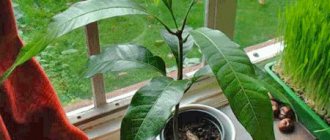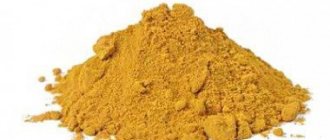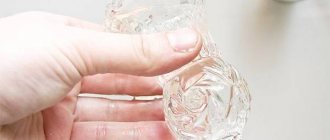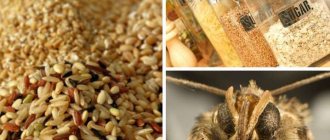First landing
It is not recommended to dry tangerine seeds, as this will sharply reduce germination. The seeds are removed from the pulp and immediately placed in the ground to a depth of 4 cm. If it is not possible to sow from the fruit into the soil, then the seeds are helped to germinate as follows:
- place under a damp cloth or in hydrogel, place in a warm place, cover with film, but leave a hole for ventilation;
- maintain moisture during the swelling process of the grains;
- After 15-30 days, the seeds and sprouts are transplanted.
Selecting seeds suitable for planting
To grow tangerines from seeds, it is better to choose hybrid seeds. Plants grown from such seeds sprout quickly, bloom early, are easily grafted, and produce edible fruit. The difference between hybrid tangerines and other varieties is the number of seeds. In the first there are plenty of them, but in the others there are either none at all, or very few of them.
You should not buy thin, dried out, blackened or severely deformed seeds. It is advisable that there be at least 5 seeds in the package, since not all of them will germinate. If you plan to graft a plant, it is better to plant at least ten seeds, since this procedure cannot always be carried out successfully.
How to transplant correctly
The sprouts are kept in small pots until the roots occupy the entire volume of soil. When the plants become crowded, they are transferred to larger containers. You cannot immediately plant seedlings in large pots. This is fraught with waterlogging of the soil and inhibition of tangerine growth.
Young plants are transshipped once a year. A well-developed, fruit-bearing tangerine is replanted after 2-3 years. In this case, the diameter of the pot is increased by 4-6 cm each time. The root collar is at the level of the soil surface.
Old and large trees are no longer replanted, but once every 2-3 years the top soil is removed and new soil is added.
Rules for planting tangerines
The first stage of growing tangerines at home is preparing soil with a neutral pH (acidic soil is not suitable for citrus fruits). Neutral substrate can be purchased in stores or prepared independently. In the second case, you need to combine 2 parts of humus, 2 parts of soil from a deciduous forest and 1 part of sand. If there is no humus, you can use a mixture of non-acidic fertile soil and sand.
You will have to wait from 15 to 30 days for the tangerine seed to germinate, and when the first shoots appear, the plant can be planted in the ground. The landing algorithm is as follows:
- Place drainage in small containers and a nutrient substrate on top.
- Deepen the seeds into the soil 4 cm.
- Cover the containers with film or a glass jar to speed up germination.
- Moisten the top layer of soil periodically as it dries.
- The jar or film is removed daily for half an hour to avoid rotting of the roots.
- After three weeks, when 2-3 true leaves appear on the sprouts, you can plant the plants in separate containers.
What fertilizers to use
Small tangerines do not require feeding. Older plants are fertilized from the beginning of the growing season - in spring and until autumn. Once every two weeks, apply liquid fertilizer for citrus fruits according to the instructions. There are other feeding options:
- Mullein infusion in a ratio of 1:10 with water.
- Chicken manure solution 1:20.
- Fish broth for fruit bearing: boil 200 g of fish or its waste for half an hour in 2 liters of water, cool and strain. Spill the soil with liquid in the morning at +17-20 ºC.
How to grow a tangerine from a seed at home: step by step
All stages of preparation and cultivation have their own characteristics, the observance of which guarantees a beautiful plant in a short time.
How to germinate - features of seed preparation
Cooked, dried artichoke, lemon or tangerine seeds are soaked for 12 hours using stimulants (for example, Zircon, Epin Extra). Such stimulation with drugs will strengthen the root system of the future plant and accelerate germination. Soaking rules:
- the soaking container should not be flat or very deep;
- the seeds are wrapped in a moistened piece of cloth;
- the container is placed in a warm place;
- The container should be placed in polyethylene to prevent the fabric from drying out.
The most favorable period to plant a seed in the soil is the beginning of February. At this time, daylight hours increase, the plant will need light. Although at the germination stage the plant does not need light as much as heat.
Selection of soil and containers for planting
The soil for planting must have a neutral pH. The soil can be prepared independently from humus, soil and sand without impurities (2:2:1). The easiest way is to pick up a special soil substrate in the store.
To germinate tangerine or orange seeds, it is convenient to use plastic cups or saucers. You can choose small pots in the store. All containers must have drainage holes.
Rules and methods of planting
The most important rule for germinating hearths of citrus trees from seeds is to place the seed in the ground as quickly as possible.
After removing the seed from the fruit, you must almost immediately place it in the ground, digging it to a depth of about 5 cm.
If it was not possible to plant immediately, they resort to soaking together with growth stimulants. After placing the seeds in the ground, shoots are expected. It is impossible to determine the exact time; it all depends on the quality of the planting material. Sometimes this period is two weeks, but most often you will have to wait a month for meetings. Read how to grow lychees from seeds here.
It is not recommended to place future plants in mini greenhouses. The tangerine tree has poor germination; such stimulation will lead to the fact that the future plant will not be able to develop outside the greenhouse conditions.
How to transplant
Depending on the type of planting and the sprout that appears, transplantation is performed:
- into different containers as soon as four leaves appear. Choose straight and strong shoots;
- if there are two sprouts from one seed, pinch one or plant two sprouts in different containers. Usually the two sprouts have different root systems.
The next transplant should take place as soon as the root system occupies the entire container.
You cannot immediately select a huge container with an eye on an adult plant - the soil may become waterlogged, which is detrimental to the tangerine.
It is recommended to replant the tree every year, if it bears fruit - three times less often. Each time the soil is replaced and a container of larger diameter is selected. When performing manipulations, it is important to monitor the safety of the root collar.
Old and very large specimens are not replanted, but the soil is renewed every 2 years, affecting only the top layer (about 5 cm) and introducing a new fertile one.
Care during flowering
During the flowering phase of mandarin, the need for potassium and phosphorus increases sharply. Strictly observe the watering regime, but do not oversaturate with water.
The tree needs frequent spraying, while trying not to get it on the flowers to avoid burns.
When the tangerine begins to bloom, it is provided with a period of rest with less frequent watering and the temperature is kept at +10-12 ºC.
The plant itself regulates the load and sheds excess buds. If falling does not occur, then the tree is helped by removing some flowers. It is considered normal when there is one fruit for every 15-20 leaves.
Pest and disease control
For a plant that was grown at home, the enemies are gnawing and sucking pests, as well as viruses and fungi. The most common are spider mites, aphids, scale insects, thrips, etc. Care involves destroying them. Use natural biological products that have beneficial properties - an infusion of onion peels or garlic.
The appearance of a thrips fly at home is the first sign of wet soil; constantly loosen the soil and allow the top layer to dry.
But infection of a tangerine grown from a seed with scale insects or spider mites can lead to the death of the plant. If you notice the finest cobwebs on the stems and leaves, make sure that this is not the work of a spider and urgently treat it with special preparations, for example, Actellik, but others will also work. But strictly follow the instructions for the drug.
You can also use folk remedies - mix laundry soap and tobacco dust in the following proportions - 10 grams, add 1 tbsp to the solution. spoons filled with a glass of water and infused for 6 days. The resulting solution should be sprayed on the plant 3 times, with an interval of 6 days.
Problems when growing tangerines
Yellowing and falling leaves
This problem can have various causes. It is important not to rush, carefully analyze the condition of the plant and make the correct diagnosis. In adult tangerines, leaves may turn yellow and fall off due to their old age. But at the same time, the tree itself looks healthy and develops normally.
General lightening of the foliage may indicate insufficient lighting of the plants. In this case, you need to take care to move the tangerine closer to the light, or provide it with artificial lighting.
The shedding of tangerine leaves can begin due to too dry air (in the absence of regular spraying, especially during the heating season), improper replanting (when the root collar is deepened, choosing too large a pot), drafts. If one of these causes is detected, they simply need to be eliminated.
The drying and falling of the lower leaves of the tangerine, while the leaf begins to dry from the tip, is associated with regular waterlogging of the soil. This phenomenon occurs either as a result of excessive care, or because the pot is too large in relation to the seedling. In any case, the plant must be transplanted into an appropriate pot with fresh, loose (breathable) soil, after removing the rotten roots.
If yellowing begins at the bottom of the crown and spreads to the top, this indicates a lack of nitrogen. In this case, the tangerine must be fed with nitrogen fertilizers.
The light yellow color of young tangerine leaves, which gradually turns to older leaves, indicates chlorosis (iron deficiency). Treatment with iron chelate will help here.
Tangerine leaves fall without any obvious reason - perhaps the plant lacks potassium. In this case, it must be fed with potassium nitrate.
Blooming tangerine tree. © Chris.urs-o
Protecting the tangerine tree from diseases and pests
Often young citrus plants grown indoors die due to pests that are barely noticeable to people.
READ ALSO: How to preserve cut roses so that they last in a vase for as long as possible
They are affected by the following pests: scale insects, citrus whiteflies, red spider mites.
To effectively combat these insects, it is recommended to use insecticides such as Actellik or Fitiverm.
Solutions of these drugs, diluted according to the instructions, thoroughly wash the leaves once a week.
The use of spraying with these drugs is ineffective.
Caring for a tangerine at home in a pot
Dear readers, the planting is complete, there is a week left until the shoots appear. Next I will tell you what kind of care you need for your indoor tangerine.
Are you ready to learn the rules for caring for a tangerine? At the same time, I advise you to learn how to graft a homemade tangerine so that it bears fruit, so that the fruit appears several years earlier than on a wild bush.
How to water
You need to approach watering the tangerine responsibly: if you water it from the tap, you will quickly destroy it. The plant tends to accumulate harmful impurities inside and transfer them to ripening fruits during fruiting.
Watering rules.
- Every day I look after the soil in the pot: I take a pinch, squeeze it - if the lump remains and has not crumbled, water it early, if it has fallen apart into small particles - it’s time to moisten.
- I collect water in advance, pass it through a filter and let it sit for 3 days.
- I water it abundantly, 0.5-1 liters per bush.
- I use water at 25-35 degrees.
Author's note Natalya Papanova Blog author
If it is possible to collect water from a reservoir, use it for irrigation.
How to feed a tangerine tree
At different periods of life, a mandarin needs different nutrition. I’ll tell you how to feed a tangerine tree growing at home.
Feeding plan.
Seedlings up to 14 weeks do not need feeding; I immediately added a complex of microelements to the soil.
- I dry the collected banana peels and grind them in a blender, adding them once a week all year round, excluding winter, before watering and loosening.
- I feed with a weekly infusion of herbs (nettle, quinoa), diluted with water in a ratio of 1:3, once every 2 weeks.
- During budding and ovary, I irrigate once every 10 days with boric acid with manganese (1 g of acid + 2 manganese crystals + 200 ml of water).
- For disinfection, I water it once every 3 months with a soda solution (1 tsp + 3 liters of water).
Watch the video on how to fertilize a citrus bush during active fruiting.
When and how to replant correctly
Seedlings that are 3 months old need to be transplanted into a container with soil for a young plant, then I replant them every 3 months during the year, increasing the pot by 5 centimeters and once a year from one year old to 5 years old, after that - after 3 years. I will describe the transshipment process in detail.
- I take the container 2 times larger than before, the root system grows quickly.
- I pour expanded clay on the bottom for drainage.
- I cut the glass on both sides and carefully take out the earthen lump with the plant.
- I place it in the center of the pot on expanded clay.
- I fill it halfway with earth.
- I lay a layer of dry ground tangerine peels.
- I fill and compact the soil to the top.
Watch a video on transplanting a tangerine.
Formation
Dear readers, small tangerine varieties do not need pruning unless crown formation is required for beauty. Read the nuances of tree design.
Pinching scheme.
- On seedlings, after the 5th leaf appears, I pinch the crown.
- On the side branches I remove the growth so that a spherical crown is formed evenly.
- Mandarins that require grafting do not need to be pruned.
Don't like tangerines? Then hurry up to find out how to grow pomegranate at home and you can sow your favorite fruit.
When and how does it bloom
My green pet began to bloom 3 years after vaccination, in early April. As experienced flower growers advised, I took a warm shower before the buds opened.
Tangerine inflorescences are small, white, with a rich aroma that spreads throughout the apartment; the buds open gradually. 5 months after flowering, small tangerines gradually ripened.
If a tangerine does not want to bloom, you can provoke the appearance of buds by making a cut with a sharp knife at the base of the trunk. From the resulting shock, flowering begins.
Mandarin during budding
Watch the video on how to care for a tangerine.
How to care in winter
Friends, the tree needs rest. The dormant period occurs in winter; during these months it may shed some of its foliage.
- At the end of December, it is better to place the tangerine in a window where the temperature will be 15 degrees.
- I don’t remove the fruits from the bush until they are ripe.
- I reduce watering to a minimum, once every 2 weeks.
- I don’t apply fertilizer until the end of winter.
- I protect it from drafts and heat from heating devices.
Have you harvested? Quickly see how to store tangerines so that not a single fruit goes bad.
Tangerine bush loves fresh air











